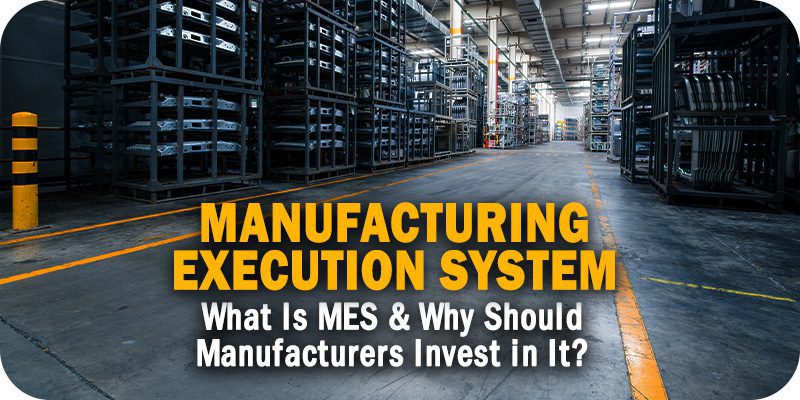What Is MES & Why Should Manufacturers Invest in It?


As part of Solutions Review’s Contributed Content Series—a collection of articles written by industry thought leaders in maturing software categories—Mike Bradford, the Strategic Business Development Director at DELMIA, gives an in-depth review of what MES is, why it’s essential for manufacturers and the key differences between manufacturing operations management (MOM) and MES.
 A manufacturing execution system, often referred to as MES, has quickly become a staple within many businesses around the globe. MES offers manufacturers a dynamic software solution capable of monitoring, tracking, controlling, and documenting manufactured products throughout production. It provides key decision-makers with the information they require to implement efficiency-driven changes to their operations.
A manufacturing execution system, often referred to as MES, has quickly become a staple within many businesses around the globe. MES offers manufacturers a dynamic software solution capable of monitoring, tracking, controlling, and documenting manufactured products throughout production. It provides key decision-makers with the information they require to implement efficiency-driven changes to their operations.
While MES has established itself with some of the major manufacturers, many businesses could still benefit from the solution but don’t have enough understanding about the tangible benefits it can bring to their operations.
What is the Difference Between MOM & MES?
First, it’s essential to differentiate between MES and MOM, as many people within the industry use the terms interchangeably despite not being the same thing. In fact, MES is actually a component of a broader MOM system, and they work hand in hand to give manufacturers capabilities that cross their entire operation.
MES primarily focuses on production, so it will integrate into your equipment and give you visibility into machine status, highlighting the operator work instructions and tracking production time. It also provides businesses with a complete production report. It can identify errors with the machine and workflow, giving your business all the information required to fix issues quickly.
In terms of a wider MOM solution, this will look at the work instructions, link to machinery, and the top equipment on the shop floor production. But the main differentiator comes where a MOM solution will also provide capabilities and visibility in other key functionality like quality, maintenance, materials, and warehouse management. You can integrate quality control, material synchronization, and maintenance planning into your overall manufacturing process so that your line-side quality, material supply, and maintenance activities are part of your production process within your MOM solution. It doesn’t require separate systems, separate reporting, or separate tracking.
Why Invest in MES?
While there is plenty of awareness about the benefits of MOM for manufacturers, the same can’t be said of MES, as there are still many within the sector who aren’t sure what it brings to the table. When investing in MES, the most important thing to note is how much value it can bring to your business, especially when helping reduce lead times.
It also reduces the overall inventory required, as businesses won’t need any ‘just-in-case’ inventory, as an MES will ensure accurate inventory records are maintained. This will ensure manufacturers can stock as much as they require with no surplus. For example, DELMIA implemented an MES solution for Cummins, a farm equipment manufacturer, and the software helped reduce their inventories by $36 million by simply having an effective MES inventory solution to reduce waste. Alongside this, throughput was increased by 25 percent due to real-time reporting and the greater visibility afforded to the company by the provided MES.
Many manufacturers will see quality and throughput improvements simultaneously when MES is in place, which can remove considerable bottlenecks in the production process. Most businesses will add quality gates during the manufacturing process to ensure the quality of each product is as high as possible; this inevitably slows overall throughput. With MES integrated as part of the process, the quality control aspects of production can be streamlined and, in some cases, removed, further enhancing the overall efficiency and profitability of the business.
It’s also worth noting that you can improve reporting because, quite often, in environments still utilizing manual inputs, they add the production and scrap counts later. In the manufacturing industry, it is widely accepted—and proven in detailed studies—that when inputting data on production statistics, there is anywhere between 85-90 percent data accuracy. The 10-15 percent variable on this can throw overall production, inventory, and scrap figures out a long way, inevitably leading to more costs in the long run. Incorporating MES into production is a sure way to improve overall reporting and remove outdated and time-consuming manual data input, saving any manufacturing business money over time.
In summary, there’s real value in rolling out an all-encompassing MOM solution at every step of that process. When pairing your MES solution with true MOM, you will likely see even more benefits and a vast reduction in inventory, waste, and overall inefficiencies. So, when it comes to the question, “Why invest?” The simple answer is that there’s real value in incorporating MES into an existing MOM solution or as a standalone product.
There is a value found typically in improvement, improved productivity, improved quality, including getting it right the first time through robust MES solutions, and all manufacturing firms should seriously consider the improved efficiencies and cost savings they can bring. Over time, manufacturers can save huge sums by removing inefficiencies and ensuring no surplus products are made. MES doesn’t get as much attention as the far more established MOM solutions do, but in time professionals within the sector certainly will see the tangible benefits that MES brings.























